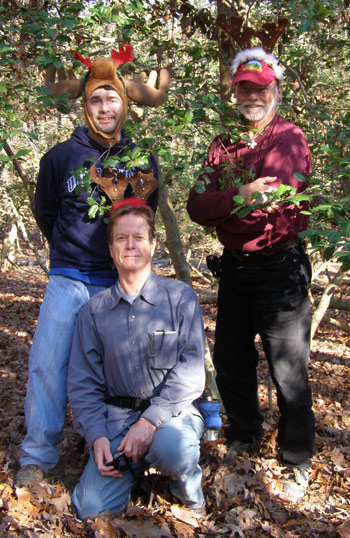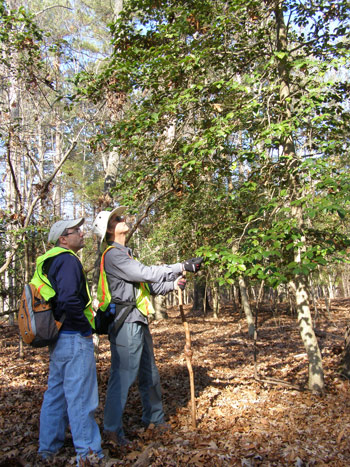Enchanted holly forest

Tony Blanford (left) and Brian Stokes dared to follow Ken Moore into the enchanted holly forest. Photo by Ken Moore
Flora Columnist
For years I have made pilgrimages to my secret forest of American holly, Ilex opaca, on the edge of Jordan Lake. This year I shared that special woodland with nature-exploring buddies Brian Stokes and Tony Blanford.
We try to explore different nearby areas weekly and sometimes we steal deep into the woods, trying to get lost. Warning: Don’t try this alone and be advised to protect yourself with brightly colored hats and orange or yellow safety vests during the winter hunting season.
By now Brian and Tony have become accustomed to some of my quirkier notions, and I appreciated their patience when I carried through with my threat to have them photographed in the holly wearing reindeer antlers. Surprisingly, Tony outdid me when he pulled out his son Campian’s rather substantial moose headgear.
So here above you see the three of us paying tribute to my “secret†forest, which I now call the “enchanted†holly forest.
All the more reason never to venture into a forest alone; you never know what you may encounter.
The evergreen holly has for centuries been a traditional plant to bring indoors for the winter season (see Flora, 12/9/10). In Archibald Henderson’s The Campus of the First State University, 1949, Dr. W.C. Coker, founder of The Coker Arboretum, described this holly in the short section, “A Naturalistic Garden.†“Often planted in Chapel Hill lawns but now quite rare in the woods because of its abuse for Christmas decorations for over a hundred years, we would like to mention the Christmas holly (Ilex opaca).â€

Dwarfed by Christmas holly, Tony Blanford (left) and Brian Stokes are wise to wear safety vests during hunting season. Photo by Ken Moore
There are so many fine cultivars of American holly in nurseries that we should all plant one or more in our gardens for year-round beauty as well as to have one’s own personal source of holly to bring indoors.
American “Christmas†holly is scattered about in the understory of local forests, but only now and then do we stumble upon an entire forest of this beautiful evergreen. Specimens such as the 200-year-old male hollies on the UNC campus and in front of Carrboro’s new fire station are seldom found in the wild these days.
When I do find myself in a far-as-the-eye-can-see holly forest, I have a sense that I’ve entered some enchanted place. That’s why I refer to this particular holly forest as an “enchanted†holly forest.
This one is easy to locate. Traveling west on U.S. 64, look for the gated abandoned road on the right just past the Parkers Creek arm of the lake. Park along the edge and follow the old roadbed a few hundred yards and you’ll spot an old logging road on the left. Walk there and soon you are engulfed in the “enchanted†holly forest.

Red berries are produced only on female holly trees. Photo by Ken Moore
Take time out of this Christmas week to discover and explore the “enchanted†forest with family and friends.
Email Ken Moore at flora@carrborocitizen.com. Find previous Ken Moore Citizen columns at The Annotated Flora (carrborocitizen.com/flora).


Comments are closed.